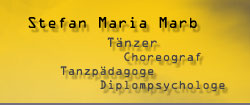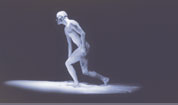| Süddeutsche Zeitung vom 19.11.2010 ( deutsch and english)
Räumliche Entgrenzungen
Stefan Marria Marbs 'Nevada_Body' in der Kunsthalle whiteBOX
München - Nevada, USA: Die Wüste wirkt unnahbar. Schemenhaft und fragmentarisch fast, wie die Figuren, die in ihr taumeln. Stefan Hagen, der Fotograf, hat lange belichtet, um diese Momente einzufrieren: die Frau im zerfließenden Kleid, die Arme gen Himmel gerichtet. Den Mann, ohne Kleider, der steht, stürzt, sich festhält am Felsen. Die slowenische Tänzerin und Choreographin Tanja Zgonc und der Münchner Choreograph und Butoh-Tänzer Stefan Marria Marb sind weit gereist, um die Begrenzungen des Raums zu durchbrechen. Für das Projekt 'Nevada_Body', das am vergangenen Freitag in der Kunsthalle whiteBOX Premiere hatte, haben sie sich in die amerikanische Wüste begeben, haben sich im Sand gewälzt mit verdrehten Gliedmaßen, nackte Körper in den Wind gehalten und einen grenzenlosen Naturraum bespielt. Eine Ahnung davon, wie Unendlichkeit sich anfühlen könnte, wird in Hagens Fotoausstellung sichtbar. Sabine Scharf ist den Künstlern mit der Kamera gefolgt und gibt Hagens Fotos eine weitere Dimension.
Fotoausstellung und Filmprojektion rahmen Stefan Marria Marbs" Live-Performance. Die beginnt mit einem Soundtrack der Elemente (Nick Parkin): Zikaden, Sand, Donner und tösendes Quietschen. Marb, im schwarzen Mantel, bewegt sich scheinbar orientierungslos im Raum. Minimalste Zuckungen regieren seinen Körper, seine rechte Hand tastet sich durch die Luft. Unerträgliche Idee der Unendlichkeit? Mit einem Ast in der Hand lotet er dann alle Ecken des Raums aus, wirbelt, keucht. Und häutet sich zum weißgekalkten Butoh-Mann, der zwischen exzessiver Groteske und meditativer Sanftheit taumelt.
Butoh ist eine moderne Form des japanischen Ausdruckstanzes und entstand Ende der 50er Jahre in Japan, als Reaktion auf Hiroshima, Nagasaki, den Westen. Butoh will die Ursprünge des Daseins ergründen. Es ist ein Tanz, bei dem alles fließt und Gefühle über den entindividualisierten Körper abgeleitet werden.
Marb hat seinen eigenen Butoh-Stil entwickelt. Bei 'Nevada_Body' oszilliert er zwischen westlichem Vorandrängen und fernöstlicher Verinnerlichung. Ein verstörender, zauberhafter Abend, bei dem die Entgrenzung sich mit Verstand kaum fassen lässt.
Katrin Kuntz
-------
Spatial Dissolution of Boundaries
Nevada-Body by Stefan Marria Marb and
Diptychs and Triptychs, by Stefan Hagen in the Kunsthalle White Box
Munich - Nevada, USA: the desert seems inapproachable. It seems vague and almost fragmentary, just as the figures that tumble in it. The photographer Stefan Hagen exposed film for an expansive of time to freeze these moments: the woman in a diffluent dress with arms stretched to the heavens; the naked man standing, falling, holding on to the rocks.
The Slovenian dancer and choreographer Tanja Zgonc and the choreographer and Butoh dancer Stefan Marria Marb from Munich traveled far to break through the confinements of space. For their project Nevada_Body, which opened last Friday in the Kunsthalle White Box, they journeyed to the American desert, rolled in the mud with torqued limbs, faced the wind with their naked bodies, and worked the limitless space of nature. You get a glimpse of how infinity could feel in Stefan Hagen's photography exhibition. Sabine Scharf followed the dancers with a video camera and adds another dimension to Hagen's photos.
Stefan Hagen's photography exhibition and Scharf's video projections frame Stefan Marria Marb's live performance. It starts with a soundtrack of the elements (by: Nick Parkin): crickets, sand, thunder, and tumultuous squeaking. Marb, in a black coat, moves through the space it seems without guidance. Minimal convulsions dictate his body; his right hand feels its way through the air. An unbearable idea of the infinity? With a branch in his hand he explores all corners of the space, whirls, wheezes. He then peels himself to the chalk-white Butoh-man, tumbling between excessive grotesque and meditative gentleness.
Butoh is a modern form of Japanese expressive dance that emerged in the late Fifties in Japan as a reaction to Hiroshima, Nagasaki and the Western culture in general. Butoh wants to fathom the roots of existence. It is a dance always in constant flow and where sentiments are derived from a body without identity.
Marb has developed his own stile of Butoh. He oscillates in Nevada–Body between a Western pressing forward and an Eastern internalization: a disturbing, magic evening, where one barely can comprehend the dissolution of boundaries. Katrin Kuntz |



